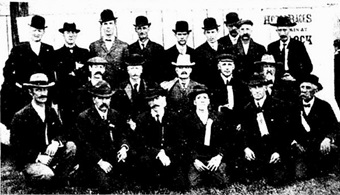
Welcome to Hemlock and Canadice Lakes!
Barns Businesses Cemeteries Churches Clinton & Sullivan Columns Communities Documents Events Time Line Fairs & Festivals Farm & Garden Hiking Homesteads Lake Cottages Lake Scenes Landscapes Library News Articles Old Maps Old Roads & Bridges Organizations People Photo Gallery Podcasts Railroad Reservoir Schools State Forest Veterans Videos
|
Some Background on the Hemlock Fair |
|
|
Some Background on the Hemlock Fair Frank Connor - The Livonia Gazette 23 August 1960 |
||
|
The Hemlock Fair Organizers in 1905 Front Row, from left: J. H. Sherman, vice-president; F. H. Ingraham, manager; William Clancy, superintendent of cattle; E. H. Westbrook, president; T. J. Wynn, vice-president. Middle Row: C. G. McCullock; William Carter, county judge; F. H. Upton, starting judge; O. A. Beam, vice-president; S. D. Short, trustee. Back Row: Nine men are shown here, but only seven names are written on the back. Dr. F. A. Wicker, a past president is first on left. From the right the first four are apparently E. E. Coykendall, vice-president; W. B. Thurston, treasurer. That leaves four men, but only two names to go with them: Sam Johnson, trustee, and George (Schwan?), listed as trustee, though the 1905 book gives no one by that name. Maybe you, the reader, can tell which is which and who the other two are. These names were listed on the back of a picture from Frank Connor’s collection, which was taken in front of the grandstand by Albert R. Stone, Rochester commercial photographer of that day. This year, 1960, marks the 94th of the Hemlock Fair and the 89th exhibit. Taking in the stock shows of fairs of Livoinia, Conesus, Honeoye and Hemlock, and racing held on various straight roads about this section, fair history will date back to something over a century. This entire section was noted for its blooded sheep merinos and coarse wools, and Josiah Short told me that he exhibited a pen of Merinos at a Paris stock show. They must have had some good ones. Other livestock must have been average, as pigs were listed as either black or white, and there were 12 breeds of chickens, ducks and geese in the 1877 book. In 1910 there was a showing of 444 classes and breeds of poultry. In 1877 the ladies department was showing handmade quilts, tidies, breakfast shawls, men’s suits (apparently no tailors were around yet), tucked suits, needlework and baked goods. There were 11 divisions of this department. No small part of a fair, before World War II, were those who held the privileges. Some of these people came year after year and seemed to become a part of each fair. For one, there was E. I. Adams who had a hot dog stand. During a visit with him, he told me that at times when the society needed money to get ready for a fair and they were already in debt, he would put up the money (this was confirmed by Ed Westbrook). E. I. had his choice of a spot for many years. Then there was the old fellow who sold the horsewhips, sometimes four for a dollar. Later S. D. Burrett, jeweler of Rochester teamed up with him and sold unclaimed watches. Some ran a week, some years; a lot depended on what you paid for it at auction. Another was Kummi John and his popcorn wagon, the popper turned by a small steam engine. I think the ferris wheel turned up 1901 or 1902 after the World Exposition at Buffalo. In 1910 the fair put on a stake-race for $1000. A horse named June was entered in it and one named Lottie Hal. Lottie came in on railroad the day before and was kept in the box-car until race day. The race was rained out and postponed until the following Saturday, one week. The Lehigh operated a special train for the occasion. Lottie Hal came in first and June second. While Lottie Hal was being loaded back into her box-car, the owner of June appeared and demanded first money. It was paid him without argument. Lottie Hal had been outlawed on N.Y. State tracks. Her owner had changed her name and dyed her two white forlegs to make her a solid brown color. Dan Short was president of the Hemlock fair society when the exhibition was held in 1876 at Short’s Driving Park. Opinion is divided as to the location of the park, some holding that it was between the present Honeoye Road and Nathan Short’s, others that it was on the north side of the area between the east and west lake roads. The 1877 fair was at Ackley’s Driving Park, the present fairground location. Horace (Hod) P. Hoppough was president in 1878 and 1879, with the exposition held at Ackley’s Driving Park. The Ladies Hall was erected at that time. President in 1880-81 was Andrew Kuder of Conesus and at this time advertising was dropped from the fair book. F. B. Francis of Lima filled the presidency in 1882-83. Advertising returned to the fair book in 1884-85 when Spencer Short of Honeoye was president. Succeeding Mr. Short were Sam Bonner of Lima, 1886-87, and R. H. Wiley of Springwatr 1888. Horace P. Hoppough again was president from 1889-91. Editors Note: The remainer of this article has not been found and will be posted when it is found. |
||
